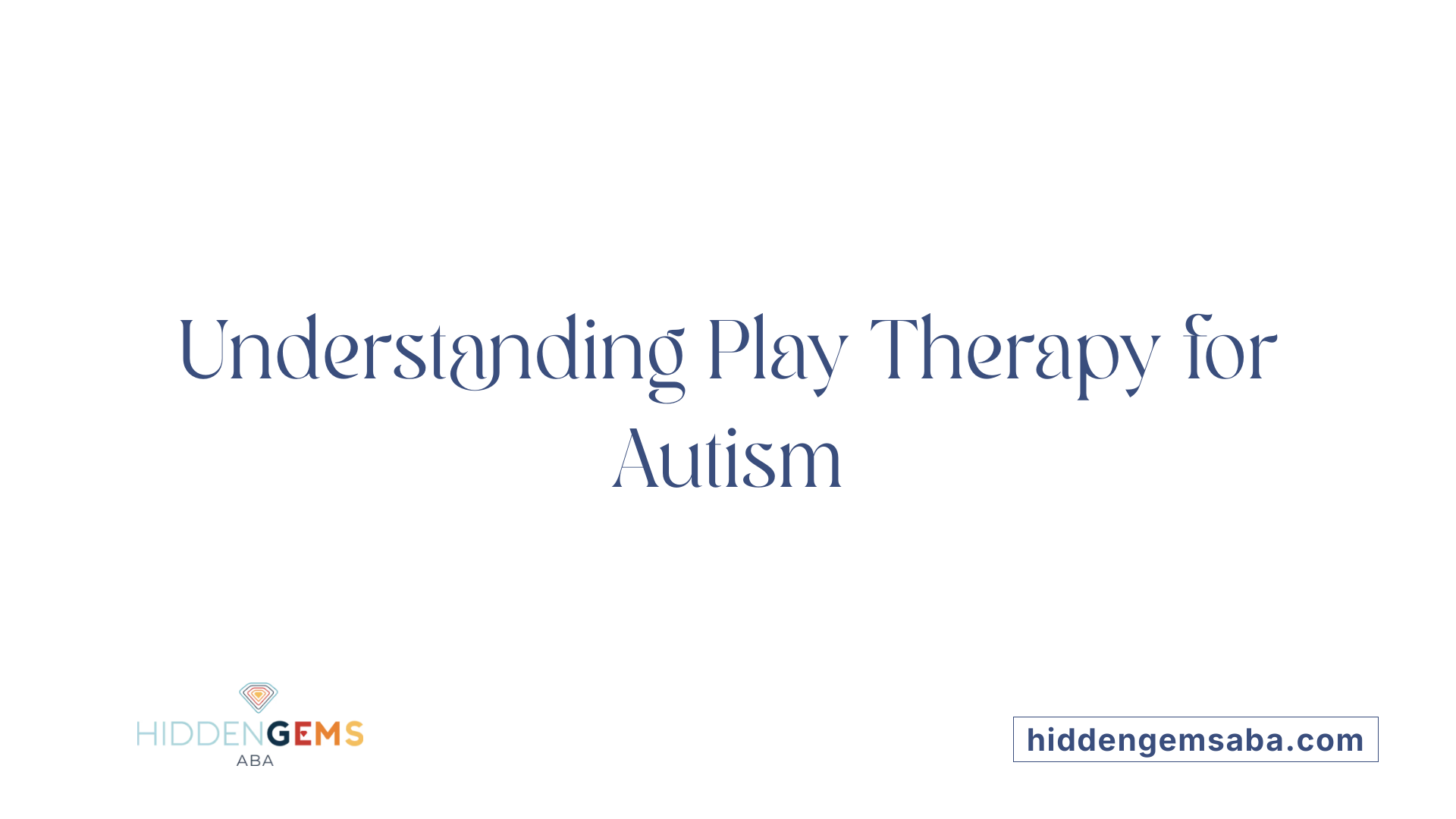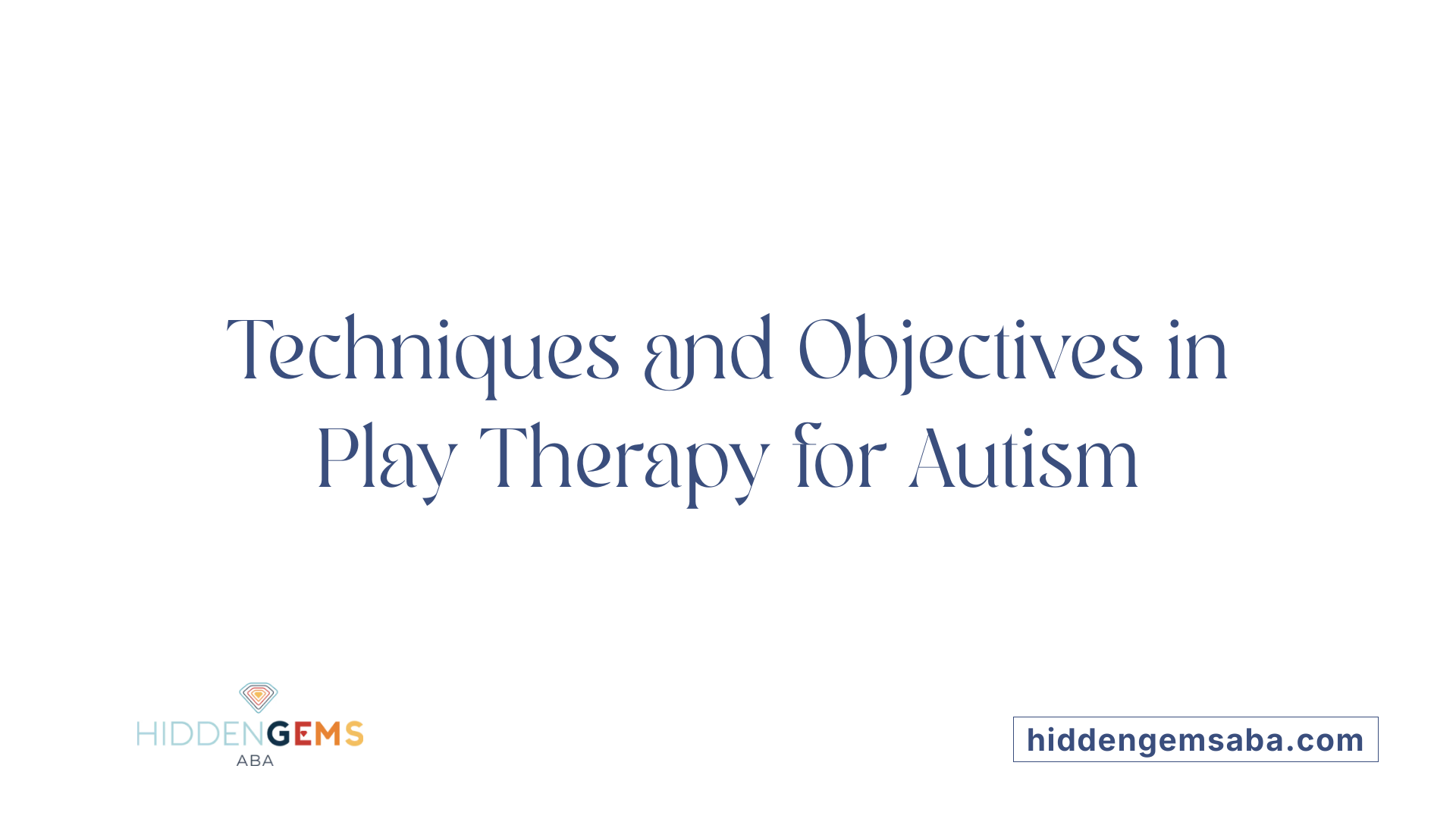Understanding the Power of Play in Autism Treatment
Play therapy holds a pivotal role in supporting children with autism spectrum disorder (ASD). By harnessing the natural, joyful activity of play, therapists can facilitate emotional, social, and developmental growth. This article explores the multifaceted benefits of play therapy, its techniques, scientific support, and how it forms a core part of early intervention strategies for children with autism.
What Is Play Therapy for Autism?

What is play therapy for autism?
Play therapy for autism is a child-centered approach that uses structured and free play activities to support children’s emotional, social, and communication development. It provides a safe environment where children can express their feelings and work through challenges using toys, arts, pretend play, and sensory activities. The goal is to help children with autism engage in meaningful play, which in turn fosters relationship-building and emotional regulation.
Different play therapy techniques, including DIR/Floortime, art-based therapy, and sensory integration, can be customized to each child's needs. These methods aim to enhance social interaction, communication skills, and behavior management while supporting overall brain development.
This approach emphasizes observing children’s play patterns, setting individualized goals, and involving family in the therapeutic process. Proper assessment by trained professionals is vital to choose the most effective type of play therapy. When combined with other therapies like speech or occupational therapy, play therapy can significantly improve the quality of life and developmental progress for children with autism.
Utilizing play as a natural language, this intervention helps children express emotions nonverbally or verbally, develop empathy, and build confidence. The activities are designed to match children’s interests and developmental levels, making therapy engaging and impactful. Overall, play therapy is a gentle, adaptable method that leverages the power of play to promote growth in children with autism.
Benefits and Outcomes of Play Therapy for Autistic Children

How does play therapy enhance emotional, social, and communication skills?
Play therapy provides a safe space for children with autism to express themselves freely through play activities they enjoy. It helps them develop crucial social skills like turn-taking, sharing, and understanding nonverbal cues. As children engage in structured or child-led play, they learn to communicate better—whether through words, gestures, or facial expressions. Approaches like Child-Centered Play Therapy and Floortime focus on building relationships, encouraging children to connect with others while exploring their feelings and thoughts.
Play also facilitates emotional growth by allowing children to identify and regulate their feelings. Activities like pretend play and sensory exercises promote emotional understanding and resilience. This natural form of expression not only improves social interaction but also boosts confidence and encourages creativity.
How does play therapy help develop self-regulation, confidence, and independence?
Engaging in play allows children to practice self-regulatory behaviors, such as calming themselves after an upset or managing sensory overload. Structured routines with visual aids help children understand expectations, which fosters independence and decision-making skills. As children successfully navigate play scenarios, they build self-esteem and a sense of mastery.
Therapists often incorporate goal-oriented activities that promote problem-solving and manual dexterity. These experiences empower children to feel more autonomous and capable, laying a foundation for lifelong confidence.
In what ways does play therapy contribute to reducing anxiety and stress?
Early intervention through play therapy creates a reassuring environment where children can explore activities comfortably. This helps diminish feelings of anxiety by providing predictable routines and sensory-based activities like swinging, jumping, or using weighted objects, which regulate sensory input.
Techniques like DIR or the PLAY Project focus on building positive, trusting relationships with caregivers, further reducing stress. As children become more adept at expressing emotions and engaging socially, their overall anxiety levels tend to decrease.
| Outcome Area | Benefit | Description |
|---|---|---|
| Emotional Skills | Regulation & Growth | Children learn to identify and manage emotions through expressive play activities. |
| Social Skills | Enhanced Interaction | Play encourages sharing, turn-taking, and understanding social cues. |
| Communication | Verbal & Non-verbal | Children improve both speaking and expressive gestures, increasing their ability to communicate needs and feelings. |
| Self-Confidence | Increased Autonomy | Success in play builds self-esteem and encourages independence. |
| Anxiety Reduction | Emotional Safety | Predictable, sensory-rich activities help children feel secure and reduce stress |
In summary, play therapy can significantly enrich the emotional, social, and behavioral development of children with autism. By nurturing communication, emotional regulation, and social understanding, it supports children in overcoming challenges while fostering confidence, independence, and resilience.
Supporting Developmental and Emotional Needs Through Play

How does play therapy support developmental and emotional needs in children with autism?
Play therapy is a valuable approach that allows children with autism to express themselves comfortably and learn crucial skills through structured and unstructured play activities. It creates a safe space where children can explore their feelings, practice social interactions, and develop communication skills. Techniques such as role-playing, storytelling, sensory activities, and art-based play are often used to meet each child's unique needs.
Through engaging in play, children improve their ability to understand and regulate emotions, which can help reduce anxiety. Play therapy also encourages social skills like turn-taking, sharing, and interpreting nonverbal cues, contributing to better social interactions.
The therapy is designed to foster trust and confidence by allowing children to lead the activities, promoting independence and emotional resilience. As children become more comfortable expressing their feelings and working through challenges, their overall emotional well-being improves.
When combined with other treatments like speech or occupational therapy, play therapy enhances their development holistically. It not only aids in cognitive and social growth but also empowers children to handle their emotions better, fostering a more positive outlook towards learning and social relationships.
Techniques and Goals of Play Therapy in Autism Treatment
 Play therapy for children with autism employs a variety of engaging and therapeutic techniques designed to foster development across social, communication, and emotional domains.
Play therapy for children with autism employs a variety of engaging and therapeutic techniques designed to foster development across social, communication, and emotional domains.
Common methods include sensory activities, role-playing, pretend play, and the use of visual aids such as social stories and schedules. Sensory play, like swinging or weighted objects, helps regulate sensory processing difficulties and promotes self-awareness. Role-playing and pretend play enable children to practice social roles and understand different perspectives, which are vital for social skills development.
Therapists may also incorporate puzzles, art activities, and sensory toys to encourage participation and learning. These tools serve as mediums for self-expression and interaction, allowing children to explore their feelings and experiences comfortably.
The overarching goals of this approach are to improve how children with autism connect with others, communicate effectively—both verbally and non-verbally—and regulate their emotions. Enhancing sensory processing, increasing social interactions, and developing problem-solving skills are central outcomes.
Approaches in play therapy are highly adaptable to each child’s unique needs. Some therapies are child-centered, emphasizing the child’s choices and spontaneous play, while others follow structured guidelines or specific models like DIR/Floortime, which focus on emotional development through play.
Through these techniques, children learn to navigate their environment better, express themselves confidently, and develop vital cognitive and motor skills. The flexible, individualized design of play therapy makes it a powerful tool for supporting children with autism in achieving their full potential and improving overall well-being.
Scientific Evidence Supporting Play Therapy's Efficacy

What evidence supports the effectiveness of play therapy for children with autism?
Research indicates that play therapy can significantly improve social, emotional, and behavioral skills in children with autism. Studies show that children participating in play therapy often display increased abilities in joint attention, imitation, and emotional expression — all crucial for social development.
One of the measurable neural changes associated with play therapy is reflected in EEG studies, where increases in alpha wave amplitudes suggest enhanced neural connectivity. These biological markers are complemented by improvements in behavioral assessments such as the Social Responsiveness Scale (SRS-2) and the Adaptive Behavior Assessment System (ABAS-II).
Several types of play therapy, including child-centered play therapy and sensory integration approaches, have demonstrated the potential to reduce core symptoms of ASD and alleviate behavioral problems. For instance, some research reports notable decreases in autism severity scores following structured play interventions.
Parents and clinicians also observe that play therapy encourages children to express themselves more freely, which enhances their daily social functioning and emotional regulation. Despite these promising findings, the overall strength of the evidence remains limited, highlighting the necessity for more rigorous, large-scale studies.
In summary, while existing research suggests positive outcomes from play therapy in children with autism, further high-quality studies are essential to confirm these benefits and optimize intervention strategies.
| Aspect | Evidence | Additional Details |
|---|---|---|
| Behavioral improvements | Significant gains in social and emotional skills | Including joint attention, imitation, and emotional expression |
| Neural changes | Increased EEG alpha amplitudes | Indicating better brain connectivity |
| Symptom reduction | Decrease in core ASD symptoms | Measured by standardized tools like SRS-2 and ABAS-II |
| Study limitations | Evidence remains weak | Calls for more comprehensive research |
Explore more research on play therapy for autism through trusted sources to stay updated on emerging findings.
The Role of Play in Early Intervention and Holistic Autism Care
What role does play therapy play in early intervention and autism treatment strategies?
Early intervention with play therapy is vital for children with autism as it fosters the development of essential social, communication, and emotional skills during the early years of life. Because young children learn best through engaging, playful experiences, introducing play therapy early creates a foundation for better developmental outcomes.
Play therapy provides a safe and supportive environment where children can express themselves freely using toys, activities, or creative arts. This approach helps transfer behaviors from unwanted forms to more positive, non-injurious expressions, enabling children to explore their emotions and social cues.
Integration of play therapy into a multidisciplinary care framework enhances its effectiveness. It often complements speech therapy, occupational therapy, and behavioral interventions, allowing a holistic approach to autism treatment. For instance, programs like the P.L.A.Y. Project and DIR/Floortime focus on building relationships and emotional regulation through play.
Techniques such as structured play, sensory activities, social stories, and group play promote the learning of social behaviors, adaptive responses, and problem-solving skills. These methods leverage the child’s natural inclinations, making the learning process engaging and meaningful.
Research indicates that early, targeted play-based strategies can reduce the severity of autism symptoms and improve core social skills, including joint attention and peer interaction. The earlier these interventions are implemented, the greater the potential for positive long-term developmental and adaptive functioning.
In summary, play therapy acts as both a therapeutic and developmental tool, supporting children with autism early in life to build the skills necessary for independent and socially connected lives.
The Role of Therapists and Family in Play Therapy
What is the role of therapists and family in play therapy for autism?
Play therapists are trained professionals dedicated to guiding children with autism through engaging and meaningful play activities. Their primary role is to create a safe, structured environment where children feel comfortable expressing themselves. These therapists develop personalized treatment plans based on careful evaluation of each child's unique abilities, needs, and interests.
Family involvement is a vital component of successful play therapy. Parents are often encouraged to participate in therapy sessions, observe, and learn specific strategies that can be used at home. This active participation empowers families to support their child's continued development and reinforce positive behaviors outside the therapy setting.
Incorporating parents and caregivers into therapy helps bridge the gap between structured sessions and everyday life. It provides children with consistent support, enhances skills learned during therapy, and promotes generalization of these skills into social and home environments.
Building trust among the therapist, child, and family is essential for the therapy's success. Effective communication allows for ongoing assessment and adjustment of strategies to meet the child's evolving needs. When families are actively involved and therapies are collaborative, children often experience more significant improvements in social skills, emotional regulation, and communication.
Overall, the combined efforts of trained therapists and engaged families foster a nurturing environment that encourages positive growth, emotional security, and the development of essential life skills for children with autism.
Innovative Modalities and Future Directions in Play Therapy for Autism
What are some innovative approaches and future directions in play therapy for autism?
The field of play therapy is evolving rapidly, incorporating a variety of new techniques and technologies to better cater to children with autism. One promising area involves the use of expressive arts, such as music, dance, and visual art, which help children express their emotions creatively and non-verbally.
Sand tray therapy is another innovative modality, providing a tactile, calming environment where children can create scenes and symbols that reflect their inner world. This method enhances emotional regulation and self-awareness.
Advances in digital technology have introduced virtual reality (VR) and augmented reality (AR) tools into play therapy. These immersive environments allow children to experience social situations and sensory stimuli in a controlled, safe setting, which can improve social skills and sensory processing.
Modern therapeutic tools also include interactive multimedia and robotics, designed to engage children actively while providing consistent, predictable responses that support learning and emotional regulation.
Looking ahead, the potential for personalized interventions is significant. Technology can enable data-driven customization, adapting activities based on real-time feedback concerning a child's sensory needs, engagement levels, and progress.
Future strategies aim to combine biofeedback, neural monitoring, and artificial intelligence to create smarter, more flexible therapy models. This integration could optimize treatment efficacy, tailor interventions to individual neurodevelopmental profiles, and increase accessibility for children in remote or underserved areas.
Overall, these developments aim to make play therapy more engaging, effective, and adaptable, harnessing the latest in neuroscience and digital innovation to support the diverse needs of children with autism.
Embracing Play as a Catalyst for Autism Development
Play therapy is an essential component of autism intervention, leveraging the innate tendency of children to learn and grow through play. Its ability to foster emotional, social, and developmental progress makes it a powerful tool in both early and ongoing treatment plans. As research continues to shed light on its benefits, and innovative modalities emerge, integrating play therapy into multidisciplinary autism care promises a more effective, personalized approach to helping children reach their full potential.
References
- Play therapy in children with autism: Its role, implications, and ...
- Play therapy in children with autism: Its role, implications, and ...
- Play Therapy for Autism: Benefits, Techniques & Tips - Forbrain
- Play Therapy For Autism: What Parents Need to Know - Blue ABA
- Play Therapy's Role in Pediatric Autism Services for Kids
- The PLAY Project | Autism Treatment | Autism Intervention Program
- Reducing Anxiety in Children with Autism with Play Therapy
- Which Therapies Can Help with Autism? - WebMD
- A Guide to Play Therapy for Children on the Autism Spectrum
- The Role of Play Therapy in Autism Treatment





